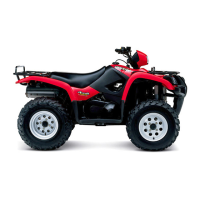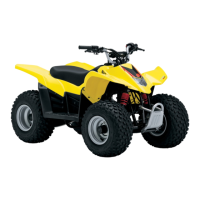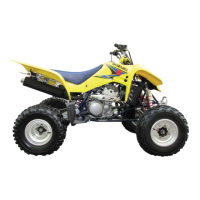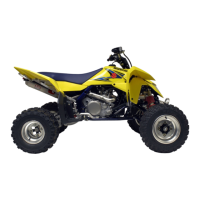Engine Lubrication System: 1E-2
Diagnostic Information and Procedures
Engine Lubrication Symptom Diagnosis
B831G21504001
Oil Pressure Check
B831G21504002
Check the engine oil pressure periodically. This will give
a good indication of the condition of the moving parts.
NOTE
Before checking the oil pressure, check the
following.
• Oil level (Refer to “Engine Oil and Filter
Replacement in Section 0B (Page 0B-10)”.)
• Oil leaks (If leak is found, repair it.)
• Oil quality (If oil is discolored or
deteriorated, replace it.)
1) Remove the right inner fender. Refer to “Front Side
Exterior Parts Removal and Installation in Section
9D (Page 9D-6)”.
2) Remove the belt cooling intake duct. Refer to “V-belt
Cooling Duct Removal and Installation in Section 5A
(Page 5A-5)”.
3) Remove the main oil gallery plug (1).
4) Install the oil pressure gauge and attachment into
the main oil gallery.
5) Connect the tachometer to the high-tension cord.
Special tool
(A): 09915–74511 (Oil pressure gauge set)
(B): 09915–74533 (Oil pressure gauge
attachment)
: 09900–26006 (Engine tachometer (solar
cell type))
6) Warm up the engine as follows:
Summer: 10 min. at 2 000 r/min
Winter: 20 min. at 2 000 r/min
Condition Possible cause Correction / Reference Item
Engine overheats Insufficient amount of engine oil. Check level and add.
Defective oil pump. Replace.
Clogged oil circuit. Clean.
Incorrect engine oil. Change.
Exhaust smoke is dirty or
thick
Excessive amount of engine oil. Check level and drain.
Engine lacks power Excessive amount of engine oil. Check level and drain.
1
I831G1150002-01
(A)
(B)
I831G1150003-02

